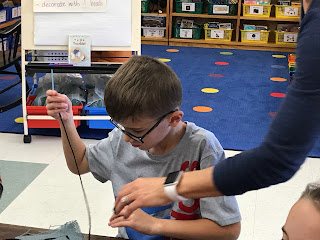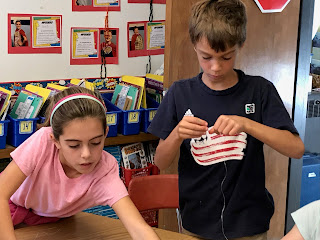New month, new seats! We did change seats on Monday. We will change seats at the end of every month.
It was nice to meet so many of you at our Parent Information Night. I hope you had a chance to look around and see where your child is during the day so when they say we were sitting on the couch or working in the reading area, you can picture that.
What's new in Room 102? As usual, a lot!
MATH:
We finished our first math unit or topic, which was the introduction to multiplication. Now we are moving on to learning our facts. Students will be learning the facts in a non-sequential order. Today we started with 2 and 5 tables. We move on from there to 9 and then to 0 and 1. The idea of doing facts in this non-standard order is that they learn to use strategies and known facts to help them solve problems with larger numbers. You can use 2 x 4 and 2 x 5 to solve 2 x 9 because 4 and 5 make 9. These strategies will help them solve larger problems and rely on facts that they do know to help them.
READING:
We have been doing several mini-lessons in our Readers' Notebooks to help us become better readers. Last week I introduced THE FAB FOUR! They are:
Clara the Careful Clarifier
Sammy the Super Summarizer
Madame the Powerful Predictor
Quincy the Quizzical Questioner
Each one of the FAB FOUR represents a strategy GOOD READERS use when reading. I have been modeling the use of these strategies in class and then students practice using them on their own.
Clara reminds us to stop when things don't make sense. We might have to "clarify" a word or a part of the story that is confusing.
Sammy helps us retell the paragraph, page, or story we read.
 |
| Quincy asks questions while he reads! |
Madame helps us make predictions about what we think might happen. We often make predictions by looking at the cover of a book as well as based on the actions or information we are reading.
Quincy asks questions! Why did that happen? What role does the setting play in the story? How did the character change as the story developed?
READ ALOUD:
 We finished All About Sam! We LOVED it! We started another of my many FAVORITES, Frindle by Andrew Clements. Nicholas Allen is a fun character. He is the boy with lots of ideas at school. But fifth grade brings one of Nick's greatest ideas yet... a NEW word. "Who says dog means dog?" his teacher, Mrs. Granger says. "You do, Nicholas." And now Nick and Mrs Granger are in a battle... or a war of words. Captain Nicholas Allen, he likes the sound of that. Nick might have won a battle, but who will win the war?
We finished All About Sam! We LOVED it! We started another of my many FAVORITES, Frindle by Andrew Clements. Nicholas Allen is a fun character. He is the boy with lots of ideas at school. But fifth grade brings one of Nick's greatest ideas yet... a NEW word. "Who says dog means dog?" his teacher, Mrs. Granger says. "You do, Nicholas." And now Nick and Mrs Granger are in a battle... or a war of words. Captain Nicholas Allen, he likes the sound of that. Nick might have won a battle, but who will win the war?
OPEN CIRCLE:
We have had several beginning of the year SCHOOL WIDE assemblies. Last week and today teachers and staff did skits about expected and unexpected behavior in the cafeteria, the hallways, on the playground, in the bathrooms, and on the bus. Students were reminded of the expectations in all these places. In our classroom, we have done Open Circles as well. Last week, we met and discussed NON-VERBAL SIGNALS. These include our school wide "Give me 5", sshhhhh, quiet coyote, bathroom requests, and "Me too or I agree with that". We compared non-verbal signals we see in sports (touchdown, strike) to ones we use in the classroom. They are known to all of us so we can communicate quietly when needed. Ask your child to share some of the non-verbal signals we use in school.
WRITING!
Our narrative writing continues. Each writing time starts with a mini-lesson. Recently we have discussed writing BIT by BIT and telling our story slowly and with good detail. Another lesson focused on good leads to the story... we tried leads using action, dialogue, and thinking. Check out these examples...
Action: I jumped up, pushed back my chair and ran for the door.
Dialogue: "Mom, is that you?" I hollered down the stairs.
Thinking: I sure hope Dad isn't going to be mad about this.
We are starting to wrap up this first unit and will choose a story to fix and fancy up for publication. That is the hard part for most third graders. Going back to look at our work again CAREFULLY is hard and identifying our own errors isn't easy.
- Do each of your sentences start with a capital letter?
- Did you tell your story bit by bit?
- Did you start your story in a way that grabs your reader?
These are the kinds of questions I want third graders to ask themselves as they edit their writing. Time and practice make the hard work of editing easier.
3rd to 3rd:
Thank you for helping out in our donations for the 3rd grade class at South Houston Elementary School. The grade 3 teachers met after school today and packed up ALL the in school donations we had collected. This does not even include ALL the online Amazon donations that were made as well. All in all, we packed up 19 large boxes of everything from sheets, blankets, backpacks, toothpaste, clothes, shampoo, etc. It was a terrific outpouring of support! Thank you for your generosity!
 |
| The donations are packed and ready to go! |


































